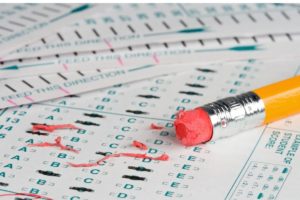Last Wednesday, April, 13th, in reaction to public backlash, Gov. Phil Murphy announced he was directing his Department of Education to review health and physical education standards approved in June 2020 by the State Board in order to “provide further clarification on what age-appropriate guidelines look like for our students.” (Full story here.)
The following day, April 14th, Acting DOE Commissioner Angelica Allen-McMillan issued the “clarification” directed by Murphy. Her entire response is below. Here is a summary.
- Allen-McMillan, speaking for the Murphy Administration’s Education Department but not the State Board, says she is issuing the clarification due to “numerous misrepresentations” (the same phrase used by Murphy) about standards. For instance, the lesson plans on gender fluidity suggested by a progressive group called Advocates for Youth at a Westfield school board meeting have nothing to do with the DOE revisions.
- To correct the record, she says, there was a five-month review period of the new standards and input from experts in the field. (Ed. Note: four of those months were during the beginning of the COVID-19 pandemic.) These standards are solely for the well-being of students.
- “Generally speaking,” the DOE does not mandate curricula or lesson plans; this is the sole responsibility of local districts. “To be clear,” she writes, “any report indicating that the NJDOE has approved a specific vendor or instructional material (e.g., lesson plan) related to the implementation of NJSLS-CHPE or any other content area is not accurate.”
Allen-McMillan then lists the three standards that “seem to have caused the most confusion.” There are:
- By the end of grade 2, students should be able to “discuss the range of ways people express their gender and how gender-role stereotypes may limit behavior.”
- By the end of grade 5, students should be able to “explain common human sexual development and the role of hormones (e.g., romantic and sexual feelings, masturbation, mood swings, timing of pubertal onset).
- By the end of grade 8, students should be able to “define vaginal, oral, and anal sex.”
Each of these standards, she explains, are age-appropriate and important for students’ mental health. For instance, children should “understand that everyone has the ability to live their life in the way that suits them, no matter their gender. They should also help children to understand that every person deserves respect, no matter their identity or expression.”
Yet the DOE understands that some families may be uncomfortable with these standards and they all have the opportunity to opt-out. She cites statute N.J.S.A. 18A:35-4.7, and says “any child whose parent or guardian presents to the school a signed statement that any part of instruction in health, family life education, or sex education is in conflict with his or her conscience or sincerely held moral or religious beliefs shall be excused from that portion of the course. Parents and guardians seeking to exercise this option should contact their local school principal directly.”
Also, local districts “are strongly encouraged to provide opportunities for meaningful engagement with the school community.”
Regarding 2020 New Jersey Student Learning Standards — Comprehensive Health and Physical Education
The New Jersey Department of Education (NJDOE) has become aware of numerous misrepresentations of the content, meaning, and role of the 2020 New Jersey Student Learning Standards for Comprehensive Health and Physical Education (NJSLS-CHPE) in guiding classroom instruction, particularly certain elements of Standard 2.1:
Personal and Mental Health. The 2020 NJSLS-CHPE were designed to address the needs of each student to gain knowledge and skills in caring for themselves, interacting effectively, respectfully and safely with others, and analyzing the impact of health choices. The standards were adopted by the State Board of Education after a five-month period of discussion, public comment, and revision. Prior to introduction to the State Board, the standards were developed in consultation with stakeholders and experts in the field.
This broadcast memo reiterates the intent and spirit of the NJSLS-CHPE; the discretion of local educational agencies (LEAs) to select and adopt curricula aligned to the NJSLS-CHPE without the need for review or approval by the NJDOE; the importance of parental input into their child’s education; the importance of LEAs’ consultation with educators, families, and other members of the school community in selecting and adopting curricula; and the ability of parents to opt-out of instructional activities aligned with these standards.
LEA Discretion to Adopt Curricula
The NJDOE does not review, approve, or actively endorse instructional materials such as sample lesson plans, textbooks, software, or videos in any content area. Generally speaking, the State does not mandate curriculum.
Material adoption is a local LEA decision, based on the local curriculum development and review process. See N.J.A.C. 6A:8-3.1. All locally adopted instructional materials should be aligned to the district curriculum and the NJSLS and be current, medically accurate, developmentally- and age-appropriate, and developed and selected through meaningful and ongoing consultation with the school community, including parents. To be clear, any report indicating that the NJDOE has approved a specific vendor or instructional material (e.g., lesson plan) related to the implementation of NJSLS-CHPE or any other content area is not accurate.
Addressing Specific Expectations
These standards are based on research making clear that receiving age-appropriate information about health education is essential for students’ physical and emotional well-being. The NJSLS-CHPE introduce core ideas that are necessary for understanding 13 disciplinary concepts, including, for example, Personal Growth and Development and Social and Sexual Health. The standards reinforce those core ideas over multiple grade levels at progressive levels of depth and complexity.
There are three standards in particular that seem to have caused the most confusion. Each are addressed in turn, below, reciting the standard first, followed by clarification of the underlying age-appropriate principles behind the standard.
By the end of grade 2:
Core Idea: Every individual has unique skills and qualities, which can include the activities they enjoy such as how they may dress, their mannerisms, things they like to do.
Performance Expectation: 2.1.2.SSH.2: Discuss the range of ways people express their gender and how gender-role stereotypes may limit behavior
Students typically begin to develop an understanding of themselves and people around them in elementary school. This is also a time when implicit and explicit messages about gender and identity can become ingrained. For instance, girls may receive messages that math and science are “boy” subjects, and boys may be taught that arts are for girls. Gendered stereotypes are real and can have negative consequences for children’s academic growth, self-worth, and mental health as they get older. These standards are designed to ensure that children understand that everyone has the ability to live their life in the way that suits them, no matter their gender. They should also help children to understand that every person deserves respect, no matter their identity or expression.
By the end of grade 5:
Core Idea: Puberty is a time of physical, social, and emotional changes.
Performance Expectation 2.1.5.PGD.4: Explain common human sexual development and the role of hormones (e.g., romantic and sexual feelings, masturbation, mood swings, timing of pubertal onset).
Children also initiate and develop relationships and navigate increasingly complex peer relationships in school settings. The inherent complexity in peer interactions can be challenging for students, from all backgrounds, and the rise in mental health concerns suggests a need to promote healthy relationships and positive self-worth at early ages. Beginning these conversations in early elementary school will help students develop empathy for a diverse group of people, and to learn about how to show respect to people no matter how they identify.
Best practice is to introduce students to information about puberty prior to its onset, so that children know what to expect (see, for example, World Health Organization 2021 and United Nations Educational, Scientific, and Cultural Organization [UNESCO] 2018). Waiting until after they have begun processing the feelings and emotions associated with puberty may leave children without the tools to appropriately process these changes. This can be a challenging time, where students’ rapid physical and emotional development can put them at risk for bullying, social isolation, and increased need for mental health supports. Instruction in upper elementary school focuses on the physical, emotional, and social changes that students may experience. The focus of instruction is to emphasize to students that developmental changes and feelings are normal.
It is important to note that the examples in parenthesis of the performance expectations are not required concepts that must be taught in classes. These are merely examples and school district curricula does not need to include these specific words or concepts in order to meet the Core Ideas or Performance Expectations of these standards.
By the end of grade 8:
Core Idea: There are factors that contribute to making healthy decisions about sex.
Performance Expectation: 2.1.8.SSH.9: Define vaginal, oral, and anal sex.
Finally, ensuring that students understand that they have agency over their own bodies is foundational to keeping them safe and protecting themselves from pressure, dating violence, and assault. It is important to provide students language for, and understanding of, specific acts, empowering them to stay safe, evaluate risks, make informed decisions, and communicate health issues or injuries if necessary. Further, youth who are unable to appropriately name sexual acts may not be able to accurately report instances of sexual harm or abuse if it occurs.
N.J.S.A. 18A:35-4.7 Parent’s Statement of Conflict with Conscience
The NJDOE recognizes and respects that some families prefer to have these conversations privately. Pursuant to N.J.S.A. 18A:35-4.7, any child whose parent or guardian presents to the school a signed statement that any part of instruction in health, family life education, or sex education is in conflict with his or her conscience or sincerely held moral or religious beliefs shall be excused from that portion of the course. Parents and guardians seeking to exercise this option should contact their local school principal directly.
Family and Community Engagement
The NJDOE believes that the strongest curriculum is one reflecting the input and expertise of the entire school community, including educators and families. Strong community partnerships in the development of curriculum will yield the healthiest learning environment. In developing curriculum and instructional materials for all content areas, LEAs are strongly encouraged to provide opportunities for meaningful engagement with the school community.
Contact information
For questions regarding the NJSLS-CHPE, please contact standards@doe.nj.gov.




